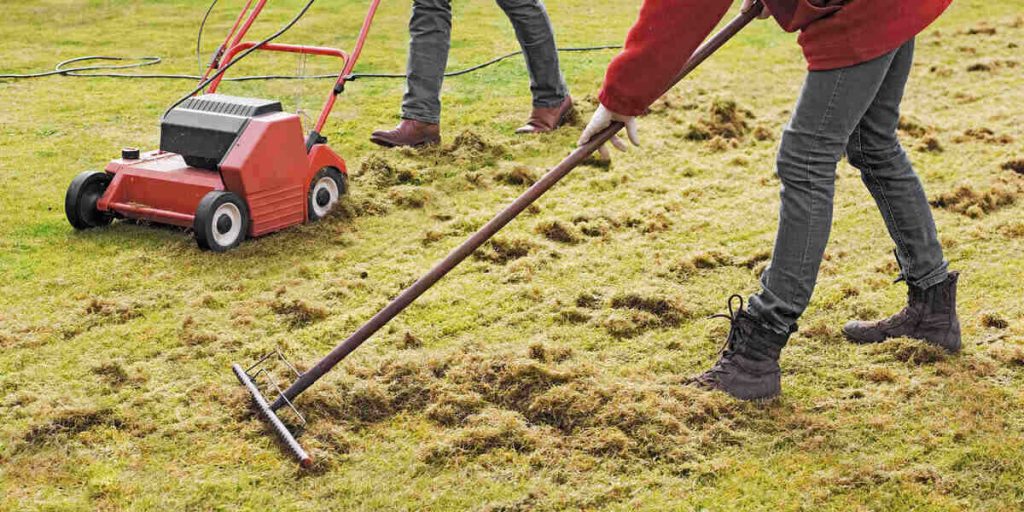Lawns are living, breathing ecosystems. They need proper care to thrive and stay healthy. One critical aspect of lawn maintenance is dethatching – removing excess buildup of organic materials known as thatch. This article will explore why dethatching is essential, the available methods, and how it paves the way for healthier, greener lawns.
Understanding Thatch
What is Thatch?
Before discussing dethatching, it’s essential to understand what constitutes “thatch”. Thatch is an accumulation of living and dead organic matter between the green part of a grass blade and soil surface, consisting of grass clippings, leaves, stems and roots resistant to decay that accumulate between green grass growth and soil surface. A small amount of thatch may serve as an effective protective layer and retain moisture; however, too much thatch creates a barrier that stops essential elements from reaching soil roots and the grass.
Problems Caused by Excessive Thatch
An excess of thatch prevents water, oxygen, and nutrients from permeating the soil, adversely impacting its health and the well-being of any lawn. It also creates an ideal breeding ground for pests and diseases while hindering weed control and fertilisation efforts, leading to drainage issues and hindering the effectiveness of treatments such as liquid aeration, overseeding, and winter mite control treatments.
Testing for Thatch
To determine whether dethatching is necessary, first inspect your lawn. Take a sample from one area, cutting away turf and soil. If the thatch layer exceeds half an inch thick, consider dethatching as soon as possible.
The Process of Dethatching
Dethatching involves the removal of the excess layer of thatch from the lawn. The primary aim is to revive the property and provide a clear path for essential elements to reach the soil and grassroots.
Manual Dethatching With a Rake
The simplest and most cost-effective method of dethatching is manual dethatching with a rake. It’s suitable for smaller lawns or areas with minimal thatch buildup. The manual dethatcher is a special rake with small curved blades designed to cut into the thatch layer, making it easier to pull up.
Electric Dethatching
Electric dethatchers are suitable for medium-sized lawns with moderate thatch buildups. These devices work like lawnmowers, with a rotating wire that pulls up the thatch as you move across the property. Electric dethatchers make the process faster and less labour-intensive than manual dethatching, but they must be more thorough.
Dethatching with a Power Rake
A power rake is preferred for large lawns or those with severe thatch buildup. A power rake is a machine with sharp tines that pulls up the thatch. It’s an efficient way to dethatch with a rake extensive grounds. The robust tines can damage the root system of the grass.
Benefits of Dethatching
Dethatching offers several benefits that contribute to a healthier, greener lawn.
Improved Nutrient Access
Dethatching removes the barrier of excessive thatch, allowing the grassroots to access nutrients more efficiently. This helps to boost the overall health of the lawn and promotes growth.
Enhanced Sunlight Penetration
Dethatching also improves the penetration of sunlight to the grassroots light is crucial for photosynthesis, the process through which grass produces its food. More sunlight makes more food, leading to a greener, healthier lawn.
Better Water Absorption
Dethatching increases the lawn’s capacity to absorb water by removing the thatch layer that often acts as a barrier to water infiltration. This means less water runoff and better soil moisture levels.
Effective Weed Control and Fertilization
Without a thick thatch layer, weed control becomes more effective as weed-killing agents can reach the soil and the weed’s roots. Similarly, the effectiveness of fertilisation is also improved as fertilisers can easily access the ground and be absorbed by grass roots, so the motion of Overseeding and Liquid Aeration.
With the thatch out of the way, overseeding becomes more effective. The seeds can reach the soil more quickly, germinate, and grow. Similarly, liquid aeration, which involves applying a liquid aerator to the ground to create space for air, water, and nutrients, becomes more effective.
Reviving Your Lawn Post-Dethatching
After dethatching, your lawn might look a little ragged but don’t worry. With the proper post-dethatching care, your property will revive and look better.
Watering
Regular and deep watering helps the lawn recover faster after dethatching. It encourages profound root growth, creating a more robust and healthier lawn.
Fertilising
Applying a high-quality fertiliser post-dethatching provides the lawn with essential nutrients for recovery and new growth.
Overseeding
Overseeding helps fill in the bare patches that may appear after dethatching. The new grass will grow alongside the existing grass, leading to a denser and greener lawn.
Weed Control and Mite Control
After dethatching, apply a weed control product to keep weeds from taking over any bare spots left by dethatching. Also, take steps against winter mites if dethatching in autumn.
Protection from Sun and Traffic
After dethatching, protect the lawn from heavy traffic and intense sunlight for at least several weeks to allow its recovery.
Conclusion
Dethatching is an essential aspect of lawn care that ensures health and beauty. Whether you use a manual dethatcher, an electric dethatcher, or a power rake – the goal remains to remove excessive thatch layers so vital elements can reach their source more readily. While dethatching might initially seem labour-intensive and time-consuming, its rewards make the effort worthwhile: healthier grass that looks greener!

